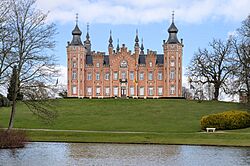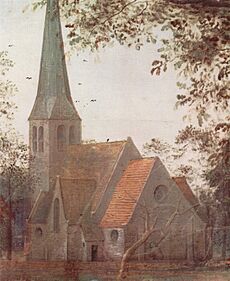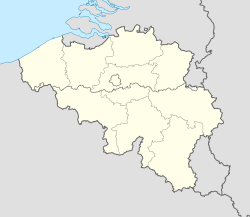Dilbeek facts for kids
Quick facts for kids
Dilbeek
|
|||
|---|---|---|---|

De Viron Castle, serving as town hall
|
|||
|
|||
| Country | Belgium | ||
| Community | Flemish Community | ||
| Region | Flemish Region | ||
| Province | Flemish Brabant | ||
| Arrondissement | Halle-Vilvoorde | ||
| Area | |||
| • Total | 41.18 km2 (15.90 sq mi) | ||
| Population
(2018-01-01)Lua error in Module:Wd at line 1575: attempt to index field 'wikibase' (a nil value).
|
|||
| • Total | Lua error in Module:Wd at line 1,575: attempt to index field 'wikibase' (a nil value). | ||
| Postal codes |
1700–1703
|
||
| Area codes | 02 | ||
| Website | www.dilbeek.be | ||
Dilbeek is a town in the province of Flemish Brabant, in the Flemish region of Belgium. It's a municipality, which means it's like a local government area.
Dilbeek is made up of several smaller villages. These include Dilbeek itself, Groot-Bijgaarden, Itterbeek (with Sint-Anna-Pede), Schepdaal (with Sint-Gertrudis-Pede), Sint-Martens-Bodegem, and Sint-Ulriks-Kapelle.
The town is located right outside the big city of Brussels. It's part of a beautiful area called the Pajottenland. Because of its location, Dilbeek is often called the Poort van het Pajottenland, which means "Gate to the Pajottenland".
Even though Dilbeek is in the Dutch-speaking part of Belgium, some people there speak French. The local council has 35 seats, and 3 of them are held by French-speaking members. Dilbeek is mostly a place where people live, but it also has some lovely countryside and a few industrial areas. A major highway, the Brussels Ring road, runs through the municipality.
Contents
History of Dilbeek
Early Beginnings
The story of Saint Alena is linked to Dilbeek. She was a Christian saint from the 7th century. Her story says she was the daughter of a local lord.
Long ago, in the time of the Carolingian Empire, Dilbeek and its nearby villages were part of a region called Brabant. This area was ruled by powerful lords. Around the year 1085, it became part of the Landgraviate of Brabant. This was a territory ruled by counts from Leuven.
The name Dedelbeccha (which became Dilbeek) was first written down in 1075. The name Bigardis, which later became Groot-Bijgaarden, appeared in 1110. In 1125, a group of nuns led by Saint Wivina started a religious community in Bigardis. Around 1183, the landgraviate became the Duchy of Brabant. Dilbeek remained an independent parish, or church area, until the French Revolution.
From the 16th Century to Today
In the 16th century, the churches in the area were moved under the control of the Archbishop of Mechelen. Also, Dilbeek, Itterbeek, and Sint-Martens-Bodegem came under the local rule of the Lords of Gaasbeek.
The years that followed were difficult due to wars between different religious groups. This led to the destruction of the Abbey of Groot-Bijgaarden. During the French rule in the 1790s, the abbey buildings were completely taken apart and sold.
Fun Events in Dilbeek
- Each of the six villages in Dilbeek holds its own yearly fairs and kermesses (festivals).
- Every spring, Dilbeek celebrates with a beautiful tulip festival.
- In the summer, there's the Vijverfestival (Pond Festival). During this event, Flemish bands play music on a stage that floats on the pond behind the town hall.
Cool Places to See

- The impressive castle of Groot-Bijgaarden was built in 1640. It has a much older tower from the 14th century. Nearby are the ruins of the original Sint-Wivina abbey.
- Dilbeek's town hall is in the de Viron Castle. This castle was built in 1863 in a Tudor style. It stands on the ruins of an old fort from the 14th century. You can still see one of the old towers, the Sint-Alenatoren, in the park around the castle.
- The countryside around Dilbeek has many old farms. One of them is Het Neerhof, a 13th-century building that once belonged to the abbey of Forest.
- The tower of the Sint-Ambrosiuskerk (Saint-Ambrose church) also dates back to the 13th century.
- The main church of Sint-Anna-Pede (in Itterbeek) was painted by the famous artist Peter Brueghel the Elder. He used it in his 1568 painting The Parable of the Blind. Today, the village has a Brueghel museum and a restored watermill from 1776.
- Dilbeek also has an interesting tram museum. It shows the history of local trams since they started in 1887.
- In the village of Sint-Gertrudis-Pede (Schepdaal), you can find the only working watermill in the Pajottenland. This old building was carefully fixed up in the 1980s and 1990s.
- You can also find Brewery Angerik, a small brewery that makes different kinds of beers.
Famous People from Dilbeek
- Saint Alena, a Christian saint who lived around 640 AD.
- Saint Wivina, who started a religious community in the 12th century.
- Romain Maes, a cyclist who won the Tour de France in 1935.
- Johan Anthierens, a journalist and writer.
- Goedele Liekens, a former Miss Belgium.
- Urbanus, a very famous Flemish comedian. He was born and grew up in Schepdaal.
- Black Box Revelation, a rock band started by Jan Paternoster and Dries Van Dijck from Dilbeek.
- Remco Evenepoel, a Belgian cyclist known as the "Schepdaal Cannibal."
Twin Cities
Dilbeek has friendly connections with other towns around the world:
 Austria: OberVellach, part of Hermagor, Austria
Austria: OberVellach, part of Hermagor, Austria United States: Dalton, Georgia, USA
United States: Dalton, Georgia, USA South Africa: Franschhoek, South Africa
South Africa: Franschhoek, South Africa
See also
 In Spanish: Dilbeek para niños
In Spanish: Dilbeek para niños




